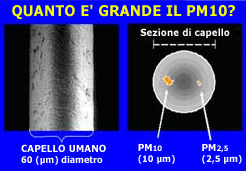
What is – Suspended particulates (Total Suspended Particles, P.T.S.) is the set of all non-gaseous material airborne. The nature of the particles is much varia: It is made up of suspended dust, the dispersed organic material from plants (pollen and plant fragments), inorganic material produced by natural agents (wind and rain), soil erosion or artifacts (more coarse fractions). In urban particulate matter may have originated from industrial processes (construction sites, foundries, cement factories), wear of asphalt, of tyres, brakes and clutches and exhaust emissions of motor vehicles, especially those with diesel engine. The health risks linked to the substances present in the form of suspended particles in the air depends, In addition to the concentration, also by the same particle size. Smaller particles pose a greater hazard to human health, because they can penetrate deep into the respiratory system. In first approximation:
- particles with diameter exceeding 10 µm; stop in the first Airways;
- particles with diameter between 5 and the 10 µm; reach the trachea and bronchi;
- particles with diameter less than 5 µm; can reach the pulmonary alveoli.
Method of measurement - Both the total particulate fraction PM10 are measured by collecting on standardized conditions filter and subsequent determination (namely for weighing) filtered dust. In the case of the PM10 fraction of the sampling equipment has a particular geometry is defined in such a way that the filter will, and are retained, only particles with aerodynamic diameter less than 10 µm.
Damage caused - Epidemiological studies have shown a correlation between the concentration of dust in the air and the manifestation of chronic respiratory tract diseases, in particular asthma, bronchiti, emphysema. In terms of indirect effects also acts as a vehicle for highly toxic substances, such as polycyclic aromatic hydrocarbons.
Evolution - the situation appears stationary or particulates in worsening and much depends on the weather. The specific situation for PM10 (particles with diameter less than 10 µm;) confirms that this fraction represents one of the most critical pollutants, especially in the urban context in view of the difficulty of remediation policies and the need to deepen the knowledge of the contribution of various sources.






